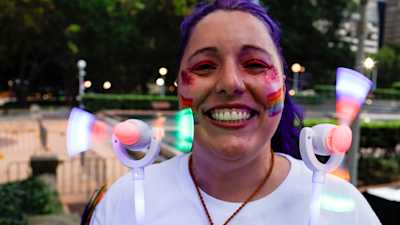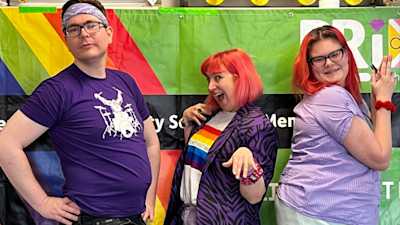Promote inclusive conversations through the power of inclusive language.

Image: Three people sit on the grass outdoors, using a laptop and writing in notebooks.
Inclusive language is a powerful tool that fosters respect, empathy, and understanding within our communities.
When we embed inclusive language into our writing and communications, we avoid perpetuating harm caused by racism, homophobia, ageism, and bias whilst promoting respect and building inclusive spaces for all.
This brief guide aims to promote respectful communication by exploring how to use language that embraces gender identities, LGBTQIA+ communities, people with disabilities, and people from diverse cultural backgrounds, whilst challenging ageism and bias.
This may help you prepare your written messages, such as social media posts, blog articles, newsletters, and promotional materials, and improve everyday communications with your colleagues, clients, and communities.
What is inclusive language?
Inclusive language is using words, phrases, or tones that are free from prejudiced, stereotyped, or discriminatory views of a particular individual or group of people.
Core principles
When you set out to apply inclusive language, it is best practice to use the following principles to inform your approach:
Use language preferred by an individual when referring to their identity, experience, or perspective. If you're not sure, respectfully ask.
Put people first. Focus on the person, not their characteristics. Instead of 'disabled person', use 'person with a disability'.
Use gender-neutral language. Using 'guys' to address all people is gendered language. Instead, use inclusive words such as folks, people, team, and all.
Use simple and accessible language. Idioms and jargon don't always translate well across cultures.
If you're unsure, ask people how they talk about themselves.
By implementing these principles, you will lay a strong foundation for incorporating the specific inclusive language practices tailored to the different communities and diverse groups outlined below.

Image: A woman with pink hair sits in her wheelchair, typing notes on a laptop.
Disability
When discussing disability, person-first language (people with disability) and identity-first language (disabled people) are both used in Australia. However, people with disability often have strong preferences for one term or the other, so it is best to follow the lead of the person or group you are talking about. And remember, it's okay to ask.
It is important to be mindful of the language used in all communications, not just when you are writing about a particular topic. Ableist language (language that is offensive to people with disability or derogatory, abusive, or negative about disability), is regularly seen in many discussions completely unrelated to disability. For example, terms like "crazy," "dumb," and "lame" are often employed without people considering the negative and ableist connotations they carry.
Ableism is the systemic exclusion and oppression of people with disability and is often expressed and reinforced through language. So, it is crucial to prioritise the removal of ableist words and phrases from your communication.
Here are some example words and phrases and their alternatives:
Instead of “idiot”, “dumb”, “moron”, or “stupid”, use “ignorant” or “uninformed”.
Instead of “crazy”, “mental”, or “insane”, use “ridiculous”, “wild”, “absurd”, “exciting”, or “unreal”.
Instead of “lame”, use “boring”, “uninteresting”, “monotonous”, “sad”, or “uncool”.
Instead of “spaz” or “spastic”, use “clumsy”, “excitable”, or “impulsive”.
Instead of “psycho”, use “scary”, “out of control”, “toxic”, or “strange”.
Instead of “crippled” or “paralysed”, use “incapacitated”, “stifled”, “overwhelmed”, “stuck”, or “frozen by”.
Instead of “blind spot”, use “area of weakness” or “lack of knowledge”.
Instead of “tone-deaf”, use “insensitive”, “tactless”, “careless”, “oblivious”, “obtuse”, or “ignorant”.
Instead of “blind”, “blindly”, or “turn a blind eye”, use phrases like “turning their back on”, “deliberately ignoring”, “neglect”, or “overlook”.
When discussing people with disability, the term vulnerable should be used with care. People with disability aren't inherently vulnerable because of their disability, but rather because of the acts or omissions of the society in which we live. Instead of using “vulnerable”, try “marginalised” or “at risk of”.
You can learn more about inclusive language for people with disability with People With Disability Australia’s Language Guide.

Image: A person in a wheelchair is outdoors on an elevated walkway.
Age
Standalone words in everyday use, like “old” and “young”, can carry bias or unintended subtext.
To avoid potential age-related assumptions, it is best practice to avoid referring to a person's age or an age group if it is not relevant. When an age or age range is relevant to a fact, you can use the term “people” with the age reference, e.g. “older people” or “young people”.
Visit the Australian Government Style Manual to learn more about age-inclusive language.

Image: Three people sit together at a wooden table, laughing and talking.
Gender
Inclusive language conveys gender equality and is gender-neutral.
Replacing gendered language with something gender-neutral increases the number of people who can 'read themselves in' to your message. LGBTQIA+ people often 'read themselves out' if language is not explicit.
You can use “they” or “them” when you would have used a singular personal pronoun such as “he”, “she”, “him”, or “her”. You can use “partner” or “parent” when you would have used “husband”, “wife”, “mother”, or “father”.
Nouns that once ended in “-man” now have neutral equivalents that include both genders, such as “police officer” for “policeman” or “policewoman”.
When discussing a specific person, using their preferred name and pronouns is a simple yet crucial way to demonstrate respect and courtesy.
To demonstrate and promote pronoun inclusivity, you can:
include pronouns in email signatures and social media profiles.
proactively share your pronouns.
ask the person about their personal pronouns or use gender-neutral terms like they/them/their.
use the person's name and pronouns that match how the person identifies now when discussing a person's past unless they request otherwise.
Access further information and resources on personal pronouns by visiting pronouns.org.

Image: Two people are standing outdoors, holding up a pride flag.
LGBTQIA+
When referring collectively to lesbian, gay, bisexual, transgender, queer, intersex, and asexual communities, you can use the acronym “LGBTQIA+”. The '+' symbol has been added to the end of the acronym to represent all other identities within the community.
It is only recently that LGBTQIA+ communities and individuals have been able to develop their own positive definitions of who they are and how they live.
We recommend using LGBTQIA+ to be inclusive of the LGBTQIA+ community in the broadest possible way, with the intention of supporting all people of diverse sexual orientation, gender identity, and sex characteristics. We acknowledge the limitations of LGBTQIA+ when speaking about the full breadth of people’s bodies, genders, relationships, sexualities, and lived experiences.
In some spaces, you may have seen the term “queer” when discussing the LGBTQIA+ community. The meaning of queer has changed a lot over the past few decades. From being used as a slur to being reclaimed by some LGBTQIA+ people and rejected by others, queer means different things to different people. Whether or not someone identifies with and uses the word queer is a personal decision, and it is best to ask their preferences before using this term.
Visit the Australian Government Style Manual to learn more about LGBTQIA+ inclusive language.

Image: Close-up of three people standing close together in front of the LGBTQIA+ flag.
Cultural Diversity
Australians have different cultural backgrounds and religious beliefs and speak many languages. You should be sensitive to these differences in your communications and speak to the person, not their difference.
You can use the general term “multicultural communities” or “culturally and racially marginalised people” to write about people from different cultural backgrounds.
As a general rule, only mention someone's cultural background or faith when it is relevant. If cultural distinctions are important, try to use specific descriptors such as “Australian-born Chinese”, “Arabic-speaking Australian”, “Jewish Australians”, or phrases that refer to a person or group's background or origin, e.g. “Australian of Sri Lankan background.” Avoid using words such as “ethnic Australians” or “ethnic groups” or referring to someone in relation to their immigration status or history unless it is specifically relevant.
It is essential to do the work to educate yourself on someone's culture and respect the cultural differences that may be present. In cross-cultural communication, you should also ensure that your language is simple and accessible by using plain English.
Visit the Australian Government Style Manual to learn more about cultural and linguistic diversity.

Image: A woman wearing a green, tan and yellow headscarf holds a baby.
Aboriginal and Torres Strait Islander Peoples
It is essential to recognise and respect that Aboriginal and Torres Strait Islander Peoples comprise of many different nations, language groups, and communities, each with distinct cultural practices, languages, and histories. By acknowledging this, we can avoid generalisations and stereotypes.
When referring to Aboriginal and Torres Strait Islander Peoples, it is recommended to use specific terminology that acknowledges their identity and respects their preferences. Terms like "Aboriginal and Torres Strait Islander Peoples" or "Aboriginal and Torres Strait Islander communities" are inclusive and should be used instead of generic terms like "Indigenous" and definitely not abbreviations like "ATSI".
Given the diversity of Aboriginal and Torres Strait Islander cultures and identities across Australia, you should always seek advice from Aboriginal and Torres Strait Islander Peoples regarding preferences and protocols around terminology.
You can learn more by reading our guide on Inclusive Language for Aboriginal and Torres Strait Islander Peoples.

Image: An older Aboriginal gentleman wearing a hat speaking to a young women wearing grey.
Ongoing learning
Maintaining a commitment to ongoing learning is crucial in understanding and promoting inclusive language. Actively seeking out resources, participating in training programs, and engaging in respectful discussions with people with lived experience can help enhance understanding and foster positive relationships.
By adopting inclusive language and respecting the diverse identities and experiences of others, we can build a more compassionate and inclusive society where everyone feels valued and empowered.
For further education, we suggest visiting:
An important note: While this guide outlines good practice terminology, it is important that we use language preferred by an individual when we are referring to their identity, experience, or perspective. Always ask for people’s preferences about what they want to be called or how they want to identify. It is usually more respectful to be specific.


